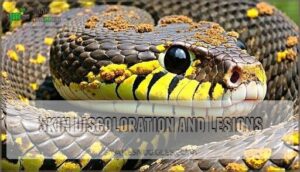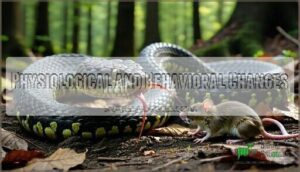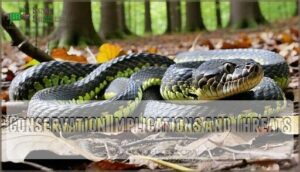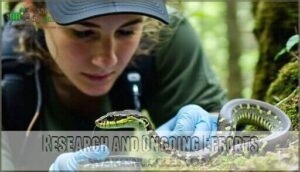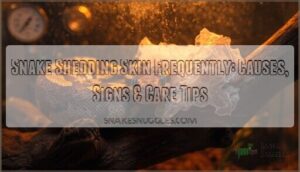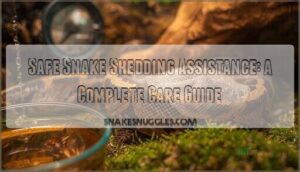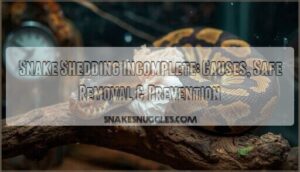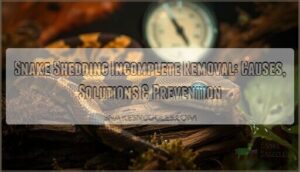This site is supported by our readers. We may earn a commission, at no cost to you, if you purchase through links.
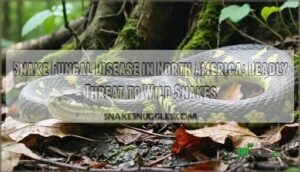 Snake fungal disease in North America threatens wild snake populations through Ophidiomyces ophiodiicola, a pathogen that’s spread rapidly since the 1980s.
Snake fungal disease in North America threatens wild snake populations through Ophidiomyces ophiodiicola, a pathogen that’s spread rapidly since the 1980s.
You’ll recognize infected snakes by their skin lesions, cloudy eyes, and facial disfigurement that can make feeding impossible.
The disease affects numerous species from timber rattlesnakes to rat snakes, contributing to population declines already stressed by habitat loss.
While researchers can diagnose SFD through skin swabs and biopsies, treatment remains challenging in wild populations.
The fungus thrives in humid conditions, making some regions particularly vulnerable to environmental factors that influence transmission, which could reveal prevention strategies that protect these essential predators, and understanding this could be key to saving them from population declines.
Table Of Contents
- Key Takeaways
- Overview of Snake Fungal Disease
- Symptoms and Progression of Snake Fungal Disease
- Diagnosis and Treatment of Snake Fungal Disease
- Conservation Implications and Threats
- Research and Ongoing Efforts
- Frequently Asked Questions (FAQs)
- Can humans get snake fungal disease?
- What is the most common fungal infection in the US?
- What is the snake fungal disease?
- What is the mortality rate for snake fungal disease?
- What fungal disease is spreading in the US?
- What is the mortality rate for snakes with fungal disease?
- How does snake fungal disease spread between snakes?
- Can humans contract snake fungal disease?
- What environmental factors contribute to snake fungal disease?
- Are some snake species more susceptible to the disease?
- Conclusion
Key Takeaways
- You’re dealing with a deadly fungus – Ophidiomyces ophiodiicola has been devastating North American snake populations since the 1980s, causing severe skin lesions and facial disfigurement that can make feeding impossible.
- Over 30 species are at risk – From timber rattlesnakes to eastern massasaugas, this disease affects snakes across six families, with some populations experiencing up to 95% mortality rates during outbreaks.
- Treatment options are extremely limited – While antifungal medications exist, they’re costly, have poor long-term effectiveness, and can’t practically reach wild populations where the disease spreads most rapidly.
- You can help by supporting conservation – Report sick snakes to wildlife authorities, support habitat protection efforts, and advocate for research funding to develop better prevention strategies before more populations collapse.
Overview of Snake Fungal Disease
If you’ve ever wondered what’s killing snakes across North America, you’re looking at one of the most devastating wildlife diseases of our time.
Snake Fungal Disease, caused by the fungus Ophidiomyces ophiodiicola, has been quietly decimating wild snake populations since its discovery in New Hampshire back in 2006, which is a devastating issue.
A silent killer stalks North America’s snakes, turning thriving populations into ecological graveyards.
Definition and Causes of Snake Fungal Disease
Snake Fungal Disease (SFD) represents a devastating threat you can’t ignore.
This emerging pathogen, Ophidiomyces ophiodiicola, transforms from captive origins into wild populations through complex transmission pathways.
Environmental factors accelerate disease emergence, making fungal taxonomy essential for understanding infections.
The fungal infections create three devastating impacts:
- Sensory destruction – compromising hunting abilities through facial disfigurement
- Respiratory invasion – spreading internally to lungs and nasal cavities
- Population collapse – threatening entire snake communities across North America
History and Geographic Distribution of Snake Fungal Disease
Since the 1940s, early SFD cases lurked undetected in museum specimens across North America.
The disease distribution spans twenty-three states and one Canadian province, with affected regions concentrated in eastern and midwestern areas.
Spread mechanisms include natural dispersal and human activities like the pet trade.
Geographic distribution reveals no wave-like pattern—instead, sporadic emergence reflects multiple fungal lineages.
Genetic sequencing suggests recent introductions of the pathogen to the U.S.
Future expansion threatens North American snakes as surveillance improves detection rates.
Affected Snake Species
Across North America, snake fungal disease affects over 30 snake species from six families.
North American snakes show varying species susceptibility, with timber rattlesnakes and eastern massasaugas experiencing devastating population impact—some outbreaks causing 95% mortality.
Geographic variation influences disease prevalence, affecting both common and endangered species.
Conservation status concerns mount as SFD in snakes spreads coast-to-coast, while researchers investigate genetic resistance patterns among different snake populations to understand vulnerability factors.
A key indicator is facial swelling, a primary clinical sign.
Symptoms and Progression of Snake Fungal Disease
When you encounter a snake with SFD, you’ll notice distinctive skin changes that progress from subtle discoloration to severe, life-threatening lesions.
The infection typically begins with yellow to brown patches on the skin, which then develop into inflamed, crusty sores that resemble boils and can lead to devastating facial disfigurement, causing severe damage.
The yellow patches spread like wildfire, transforming healthy scales into crusty, devastating sores that steal a snake’s ability to hunt and survive.
Skin Discoloration and Lesions
When snake fungal disease takes hold, you’ll observe telltale signs on infected serpents.
Scale crusting appears first as yellow or brown patches spread across the skin.
These initial lesions progress into inflamed, ulcerated scales that resemble crusty boils.
Skin thickening follows, accompanied by nodules development beneath the surface.
The infection creates a cycle where snakes may temporarily recover through shedding, but recurring skin infections often return.
Lesion progression varies among species, with some experiencing mild discoloration while others develop severe facial lesions requiring skin biopsy for proper diagnosis, which can lead to a better understanding of the disease and its telltale signs.
Physiological and Behavioral Changes
When snake fungal disease progresses beyond visible skin changes, the infection disrupts critical body functions.
Infected snakes experience compromised hunting abilities, thermoregulation problems, and mobility issues that threaten survival.
- A timber rattlesnake struggling to strike accurately at prey due to sensory impairment
- Female snakes producing fewer eggs or abandoning reproductive cycles entirely
- Infected individuals avoiding basking sites where healthy snakes gather socially
- Snakes moving sluggishly through their territories, unable to escape predators quickly
- Males failing to compete effectively during mating season due to weakened condition
The physiological changes from snake fungal disease create a cascade of problems.
Impaired mobility reduces hunting success, while reproduction impact threatens population stability.
Disease progression affects snake behavior patterns, disrupting normal social interactions and territorial movements that healthy populations depend on.
The disease is caused by Ophidiomyces ophiodiicola fungus, impacting snake populations across North America.
Severe Facial Disfigurement
When snake fungal disease takes hold, facial disfigurement becomes a devastating reality.
Ophidiomyces ophiodiicola causes severe facial lesions that create multiple survival challenges for infected snakes.
| Impact Area | Consequence |
|---|---|
| Hunting Impairment | Reduced prey capture success |
| Sensory Loss | Compromised vision and smell |
| Social Impacts | Decreased mating opportunities |
These skin infections don’t just affect appearance—they create feeding difficulties and breathing problems that threaten survival.
Diagnosis and Treatment of Snake Fungal Disease
When you suspect a snake has SFD, veterinarians and researchers use several diagnostic techniques including PCR analysis, histopathology, fungal cultures, and tissue biopsies to confirm the presence of Ophidiomyces ophiodiicola.
While treatment options exist through antifungal medications like itraconazole and voriconazole, along with surgical removal of affected tissue, these interventions face significant challenges including limited effectiveness, high costs, and the impracticality of treating wild populations.
Diagnostic Techniques
When facing suspected snake fungal disease, proper diagnostic techniques form your roadmap to accurate identification.
PCR analysis offers highly sensitive pathogen detection from skin swabs, while histopathology reveals fungal structures in tissue samples.
Fungal cultures provide definitive organism isolation, though they’re slower than molecular methods.
For conducting PCR analysis, consider using a complete analysis kit.
Skin biopsies combined with special stains enhance visualization of Ophidiomyces ophiodiicola hyphae within infected tissue, making laboratory confirmation essential for reliable disease diagnosis.
Surgical and Medical Interventions
Once your snake receives an SFD diagnosis, veterinarians deploy several surgical interventions and medical approaches.
Antifungal medications like terbinafine and voriconazole target the infection directly through topical applications or nebulization treatments. Many pet owners seek medication for their snakes when dealing with fungal issues.
Treatment protocols typically include:
- Surgical Options – Debridement removes infected tissue when lesions don’t respond to topical therapy
- Antifungal Efficacy – Daily nebulization with terbinafine achieves therapeutic levels over 3-6 months
- Wound Management – Antiseptic care and topical antifungals prevent recurrence after surgery
- Supportive Care – Thermal support, fluid therapy, and antibiotics address secondary complications
Treatment Costs remain high, limiting accessibility for wild populations.
Challenges and Limitations of Treatment
Unfortunately, treating snake fungal disease proves extremely challenging.
Treatment accessibility remains limited, especially for wild populations where antifungal medications can’t reach affected snakes.
Even when treating snake fungus is possible, antifungal resistance develops, and reinfection risks persist after recovery.
Treatment limitations include high costs and poor long-term efficacy, making treatment outcomes disappointing despite veterinary advances.
Early detection can be improved with molecular diagnostic tools.
Conservation Implications and Threats
Snake fungal disease doesn’t just threaten individual snakes—it’s reshaping entire ecosystems across North America as populations crash under mounting pressures.
You’re witnessing a perfect storm where habitat destruction, climate shifts, and human interference create ideal conditions for this deadly fungus to spread unchecked through vulnerable snake communities.
Habitat Loss and Fragmentation
Human development fragments snake habitats, creating isolated patches that reduce genetic diversity and increase edge effects.
Connectivity impacts become severe when snakes can’t move between territories for mating or food. Limited resource availability in smaller fragments makes populations vulnerable to snake fungal disease outbreaks.
Proper care involves maintaining humidity levels to prevent skin issues.
Effective mitigation strategies include wildlife corridors and protected buffer zones to maintain habitat loss prevention and support snake conservation efforts.
Climate Change and Human Persecution
Beyond habitat fragmentation, warmer temperatures from climate change create stress that weakens snake immune systems, making them more vulnerable to snake fungal disease.
Meanwhile, human persecution through habitat degradation and direct killing compounds these conservation conflicts.
Future projections indicate these combined pressures will worsen population declines.
Here’s how these forces threaten snake survival:
- Rising temperatures stress snakes and compromise disease resistance
- Habitat destruction from development eliminates safe refugia
- Direct persecution through fear-based killing reduces breeding populations
- Chemical contamination from agriculture weakens immune function
Population Declines in Key Snake Species
Snake fungal disease devastates snake populations across North America, with timber rattlesnakes experiencing over 50% declines in New Hampshire.
Eastern massasaugas face extinction risks, while Lake Erie watersnakes dropped 18% post-outbreak.
Species vulnerability depends on genetic diversity and habitat quality.
| Species | Population Impact | Conservation Priority |
|---|---|---|
| Timber Rattlesnake | 50%+ decline (NH) | Critical monitoring |
| Eastern Massasauga | Primary mortality cause | Federal protection |
| Lake Erie Watersnake | 18% decline | Habitat restoration |
Mortality rates vary regionally, with northeastern populations showing severe ecosystem impacts.
Conservation strategies focus on habitat management and long-term projections for recovery planning.
Research and Ongoing Efforts
Scientists are working hard to understand why some snakes get sicker than others from this fungal infection, and they’re testing new ways to protect wild populations before it’s too late.
You’ll find researchers examining everything from genetic factors to environmental conditions, while wildlife managers develop practical strategies to slow the disease’s spread across North America, which is a critical step to slow the disease’s spread.
Investigating Causative Agents
Scientists are investigating multiple factors behind Snake Fungal Disease outbreaks to understand this complex pathogen.
Their research focuses on:
- Environmental Factors – examining soil conditions, humidity levels, and temperature fluctuations that favor Ophidiomyces ophiodiicola growth
- Transmission Routes – tracking how SFD spreads between snake populations through direct contact and contaminated environments
- Co-occurring Pathogens – identifying other fungi and bacteria that may weaken snake immune systems
- Genetic Susceptibility – analyzing DNA variations that make certain snake species more vulnerable to infection
- Immune Response – studying how snake immune systems react to fungal invasion and pathogen identification processes
This detective work helps researchers understand why some populations suffer severe outbreaks while others remain relatively unaffected.
Examining Susceptibility and Impacts
Researchers examine what makes certain snake populations more vulnerable to Ophidiomyces ophiodiicola.
Genetic factors, immune response variations, and environmental stressors like habitat degradation influence species resilience.
Understanding these population dynamics helps scientists predict which communities face greatest risk from snake fungal disease, enabling targeted conservation efforts where disease impact on wildlife threatens population declines most severely.
Island snakes, however, may face additional challenges because of limited genetic diversity.
Monitoring Disease Prevalence
Tracking snake fungal disease requires thorough wildlife surveillance programs that combine field surveys with laboratory analysis.
You’ll find researchers conducting systematic data collection across affected regions, using standardized survey methods to document infection rates in snake populations.
Geographic trends emerge through prevalence modeling, revealing hotspots where the disease concentrates most heavily.
For effective tracking, consider essential surveillance products.
Reporting accuracy depends on trained personnel who can distinguish snake fungal disease symptoms from other conditions during routine disease monitoring efforts, which is crucial for effective tracking and understanding the impact of snake fungal disease.
Developing Effective Prevention and Mitigation Strategies
Understanding disease spread patterns helps inform where prevention efforts work best.
Researchers are developing multiple approaches to combat snake fungal disease effectively.
Habitat management reduces fungal persistence through moisture control and debris removal.
Biosecurity protocols prevent pathogen spread between sites using proper disinfection techniques.
Captive breeding programs preserve genetic diversity while public awareness campaigns educate communities about wildlife disease prevention.
Conservation funding supports these coordinated efforts across affected regions.
- Environmental controls targeting fungal reservoirs
- Strict decontamination procedures for field equipment
- Protected breeding populations for vulnerable species
- Community education on disease control measures
Frequently Asked Questions (FAQs)
Can humans get snake fungal disease?
You can’t catch snake fungal disease from infected snakes. This fungus specifically targets reptiles and doesn’t pose a threat to humans, making snake handling safe regarding this particular pathogen.
What is the most common fungal infection in the US?
You’ll find that athlete’s foot (tinea pedis) is actually the most common fungal infection in the United States, affecting millions of people annually and thriving in warm, moist environments.
What is the snake fungal disease?
Like a silent plague creeping through ancient forests, snake fungal disease strikes reptilian kingdoms with devastating precision.
You’ll recognize this emerging threat as ophidiomycosis, caused by Ophidiomyces ophiodiicola fungus, creating crusty lesions and facial disfigurement that can prove fatal.
What is the mortality rate for snake fungal disease?
You’ll find that mortality rates for snake fungal disease vary substantially by species and infection severity, ranging from minimal impact to severe population declines in vulnerable species.
What fungal disease is spreading in the US?
You’re facing Snake Fungal Disease (SFD), caused by Ophidiomyces ophiodiicola. This emerging threat’s been devastating wild snake populations across eastern North America since 2006, causing severe skin infections and mortality.
What is the mortality rate for snakes with fungal disease?
Experimental data reveals a 40% mortality rate for infected snakes. You’ll find that affected reptiles survive roughly 90 days on average when living with this devastating fungal infection.
How does snake fungal disease spread between snakes?
Direct snake-to-snake transmission of fungal disease isn’t fully understood yet. You’ll find the fungus spreads through contaminated environments, shared habitats, and possibly direct contact during mating or territorial encounters.
Can humans contract snake fungal disease?
Rest easy – snake fungal disease poses no risk to humans.
The fungus Ophidiomyces ophiodiicola specifically targets reptilian skin and can’t infect people.
You’re perfectly safe handling infected snakes with proper precautions.
What environmental factors contribute to snake fungal disease?
Environmental factors that increase snake fungal disease risk include habitat degradation, increased moisture levels, temperature fluctuations, poor air circulation, overcrowding, stress from human disturbance, and contaminated environments.
These environmental factors weaken snakes’ immune systems.
Are some snake species more susceptible to the disease?
Over 30 snake species across six families have been confirmed as hosts, but some species like timber rattlesnakes and eastern massasaugas show higher vulnerability than others.
Conclusion
While some might argue that snake fungal disease in North America affects only limited populations, this pathogen actually threatens entire ecosystems where snakes serve as essential predators.
You can help protect these species by supporting habitat conservation and reporting sick snakes to wildlife authorities.
Snake fungal disease in North America continues spreading through wild populations, making early detection and research funding essential for developing effective treatments and prevention strategies that could save these important ecosystem members.
- https://pmc.ncbi.nlm.nih.gov/articles/PMC5095536/
- https://www.woah.org/app/uploads/2021/03/ophidiomyces-ophiodiicola-causing-snake-fungal-diseaseinfection-with.pdf
- https://www.usgs.gov/diseases-of-terrestrial-wildlife/snake-fungal-disease
- https://www.fws.gov/question-answer/understanding-snake-fungal-disease-impacts-treatments-and-prevention
- https://www.frontiersin.org/journals/fungal-biology/articles/10.3389/ffunb.2023.1064939/full

